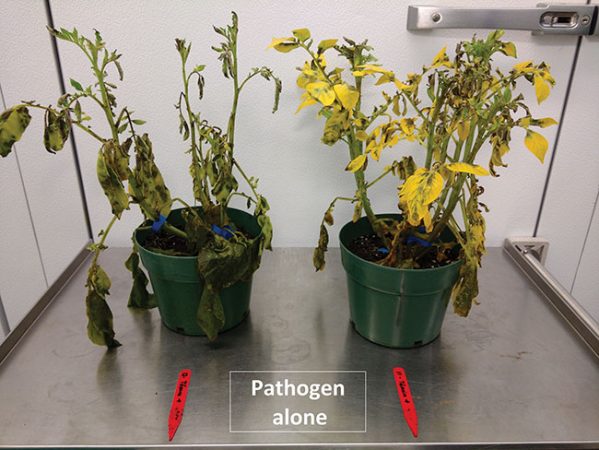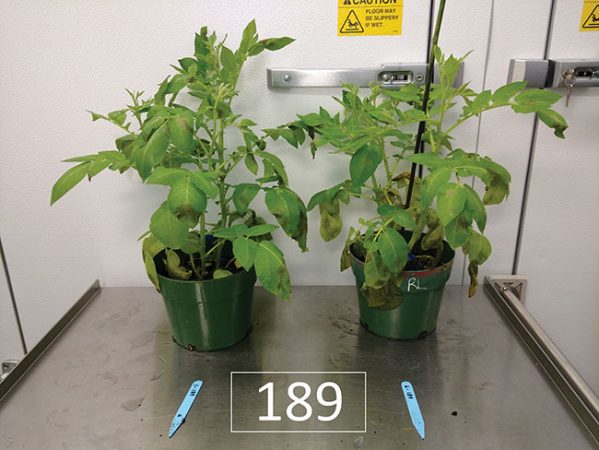
Biopesticides to fight late blight
March 8, 2019
By
Monica Dick
Late blight disease, caused by the pathogen Phytophthora infestans, continues to be one of the most serious disease concerns for potato growers. Over the past few years, new genotypes of P. infestans have emerged creating new management challenges for commercial potato growers.
These challenges have led Agriculture and Agri-Food Canada (AAFC) scientists to investigate naturally-occurring bacteria for their potential use as biological pesticides (biopesticides). The use of biopesticides has been of interest in recent years for their ability to produce powerful antifungal compounds and to induce systemic resistance in host plants.
“There are disease forecasting tools in place and registered fungicides for control. However, there are reports of P. infestans genotypes that have become more resistant to those fungicides and new genotypes are emerging,” says Sue Boyetchko, research scientist with AAFC in Saskatoon. “We wanted to investigate potential alternative control options and to reduce our carbon footprint.”
In 2013, Boyetchko and collaborator Patrice Audy, research scientist with AAFC in Quebec City, initiated a three-year project to begin screening for potential biopesticide organisms of a bacterial nature. Researchers also investigated the different genotypes that were common in North America, as well as upcoming genotypes forecast to become a problem. Several naturally occurring bacterial strains isolated from Canadian soils were discovered and showed great promise in controlling the late blight disease on potato under laboratory and greenhouse conditions. The top bacterial candidates were observed to suppress or inhibit the disease on potato by more than 90 per cent.


The team took the top six candidates and focused additional research on further screening and narrowing down the biopesticide candidates to the top one: Pseudomonas sp. strain 189, Boyetchko explains. “The good news is this organism actually produces a suite of a family of chemical compounds that contribute to its biopesticide control. Therefore, the chances of resistance developing is probably reduced. If used judiciously together with other methods of disease management, it should mitigate the risk of resistance occurring in the biopesticide. We are not using the biopesticide as a silver bullet, but wish to implement it in a disease-management system.”
The project team is now focused on strategies for scale-up and the commercialization of the biopesticide. Priorities include developing an ideal formulation for spray application in the field, maximizing bacterial survival and shelf life during storage, and developing an efficient and economic fermentation process for mass-producing the bacteria. “There was a lot of interest in our early results from several industry companies, particularly as late blight is a global disease,” Boyetchko says. Recently the team has identified an industry partner to work with, but the commercialization process will take a few years.
Researchers will also investigate agronomic practices for using the biopesticide as part of an integrated pest management program for potato growers. They want to make sure this new potential biopesticide will work with other synthetic fungicides and cultural control practices growers are currently using to manage the disease. If commercialized, this biopesticide will be an additional pest management tool in the tool box for growers.
“Our goal is to make sure our Canadian farmers benefit from our new technology introductions,” Boyetchko adds. “Most importantly, through this process we have also developed a template or roadmap for how to pursue other potential biopesticide projects, and how to collaborate with other industry partners and expertise to bring new biopesticide control options to growers.”